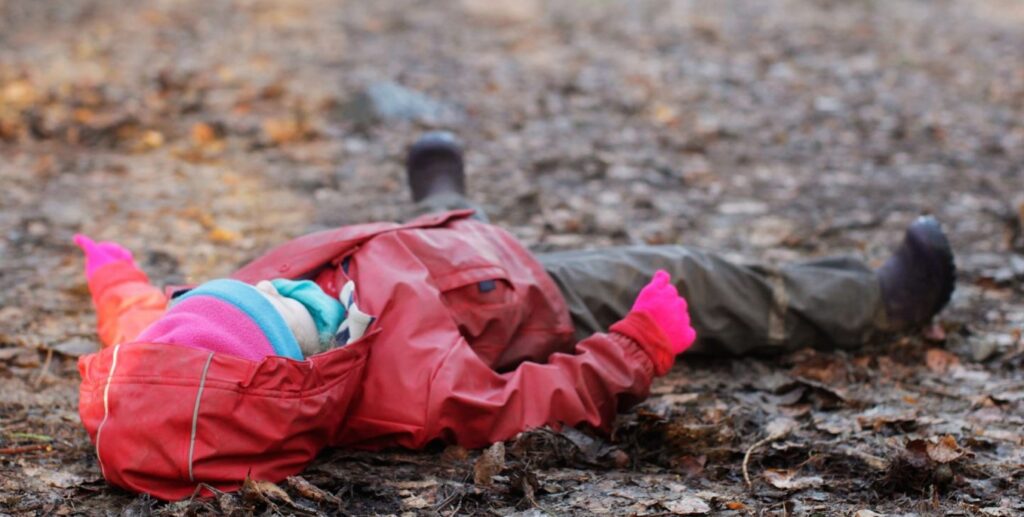As much as possible, when facilitating play for children at the Secret Garden we try to hold the space without taking ownership of it, in a culture of ‘stepping back,’ a gentle yet powerful tool.
One intuitive practitioner worded it perfectly when she said she felt we should be ‘like trees.’ This puts us just outside the frame of play, protective but unobtrusive, not interrupting or directing, and simply maintaining a respectfully distant, quiet watch.
This approach is in concession to the fact that children seemingly at play are actually working hard-creating, testing, inventing and negotiating without adult input is where bonds form, links are made and minor triumphs tot up to major achievements, in social and physical development, and in a healthy trickle of pride, contentment and self-worth.
In every season it can sometimes be necessary to breach this code and step forward again if children need support to interact with each other safely and respectfully, but in the winter months this can increase for a variety of reasons; most presciently there is just simply a need for more 1:1 care.
Ensuring gloves and hats are on, mats are sat on and children are warm and dry, wellies and waterproofs are secured with socks free from leaf-litter or other uncomfy detritus, innovative strategies for pins and needles communicated and tissues distributed, the woods in winter can be thrilling and beautiful but equipping ourselves against the elements and modelling good self-care is vital to maintain equilibrium.
Keeping spirits up and positive associations with nature ticking along are equally vital, particularly for new Secret Gardeners who haven’t yet experienced a full year in the woods and therefore have not yet been through a full seasonal learning cycle.
So we adapt…beginning with our daily routines. Knowing one of the best ways to stay cosy and rosy is to generate some of your own heat, in the park we try and discourage too much sitting on the swings and to encourage chasing games or climbing and clambering.
We try to keep a good pace walking up and down the hill to the woods, and try to make sure that everyone is kitted out comfortably, to their individual preferences, before setting off. Some children will often feel cold, some hardly ever will.
Warm lunches or a warm drink with lunch are highly recommended, so if children have brought flasks these will be met with great enthusiasm. Post-lunch, the story will often be short and sweet, or incorporate more actions or song, to get the blood moving and muscles engaged after a period of stillness.
Yoga or ‘adventures’ to other parts of the woods are good afternoon activities if children are struggling to zip back into play.
Laughter and fun being the most warming of all, this is also the time of year when staff and children can really revel in the joy of games. Scavenger hunts, Hide and Seek…Flood, Fire or Freeze…What’s the Time Mr. Wolf? and many others devised by one of our especially inventive practitioners not only warm the body but also the soul, reinforce connections with the children, and can provide a wonderful distraction from conditions that some may find challenging.
Winter is also fantastic for giving the children the opportunity to help with seasonally-appropriate jobs. Dragging a trug and collecting sticks on a crisp day, learning to saw, hammering rocks or spreading straw all introduce an element of fun, risk, and physical exertion, inspiring confidence via a selection of achievable challenges.
In our Spiral Curriculum, there are a few symbols that glow particularly brightly at this time of year. Ivy (willingness to express needs and ask for support) Silver Birch (showing signs of being confident and feeling safe with others, using assertive and responsible strategies) and Squirrel (sometimes taking initiative with ideas and leading others).
As practitioners, we try to nurture these by modelling warmth in our words and our deeds.
‘Are you nice and cosy?’ has proven to be an inspirational little couplet for encouraging Ivy and Silver Birch moments- it is head, heart and hand-warming to witness children helping themselves and each other with finding and putting on hats, jackets and gloves.
In the post-lunchtime hubbub we might dial up a couple of notches from our usual Whispering Practitioner volume to announce ‘I’m just going to put another layer on as I’ve been sitting still for a while and I want to be nice and cosy.’
Nice and cosy…nice and cosy…reminders, gentle, consistent and demonstrable, of how to stay comfortable and therefore stay curious-are peppered throughout the day.
Extra layers quietly placed behind children as they eat, clean gloves put on after handwashing, warm fires to sing into and a blanket-lined tent for anyone who needs a rest in a quiet corner… there are so many ways to stay happy in the wild and once established these echo through the days and weeks to circle back again in lovely Squirrel moments.
The children can and do learn the limits of their own comfort and start to manage it on their own terms, inspiring others to do the same.
Staying comfortable enables us to stay curious, and to keep seeking out experiences in the open air-be that icy, wet, or blustery-that reward and fortify us. Looking back once more to the Spirals, the Scots Pine symbol represents ‘a sense of wonder and willingness to explore and engage with new places.’ A tree, and an idea, which is evergreen, and a reassuring constant throughout the year.
Written by Mazz Brown.

